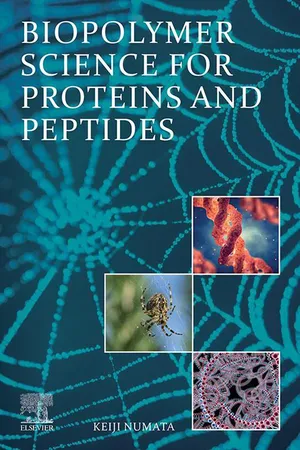
- 308 pages
- English
- ePUB (mobile friendly)
- Available on iOS & Android
Biopolymer Science for Proteins and Peptides
About This Book
Biopolymer Science for Proteins and Peptides introduces all aspects of natural polymers based on structural proteins and peptides, presenting synthesis, structure, properties, proteins, materials design, and applications.
The book begins by presenting the core concepts of polypeptide and protein materials, before discussing synthesis and structure in detail. The next part of the book describes physical properties, biological properties, and issues surrounding stability. Subsequent chapters offer in-depth coverage of both natural and structural protein sources, including collagen, silk, elastin, resilin, keratin, foot protein, and reflectin, and the materials that can be designed from them, such as films, fibers, textiles, microparticles, sponges and scaffolds, nanomaterials, blends, and composites. These materials are also analyzed against the available synthetic polymers. Finally, the text explores current applications and potential future developments.
This is an essential resource for researchers and advanced students across a range of disciplines, including biopolymers, structural proteins, polymer science, materials science, biomaterials, biology, biotechnology, chemistry, engineering, and pharmaceutical science. In an industry setting, this is of great interest to scientists and R&D professionals working in industries with an interest in bio-based polymers for advanced applications.
- Explains how biopolymers from structural proteins and peptides can be developed into materials, such as films, fibers, textiles, microparticles, sponges and scaffolds, nanomaterials, blends, and polymer composites
- Provides the reader a solid understanding of the structure, synthesis, and properties
- Guides the reader from sources, including collagen, silk, elastin, resilin, keratin, and reflectin, to material design and cutting-edge applications
Frequently asked questions
Information
Table of contents
- Cover image
- Title page
- Table of Contents
- Copyright
- Preface
- Chapter 1. General introduction of polypeptide and protein materials
- Chapter 2. Synthesis
- Chapter 3. Structure
- Chapter 4. Physical properties
- Chapter 5. Biological properties with cells
- Chapter 6. Stability
- Chapter 7. Structural proteins in nature
- Chapter 8. Biopolymer material and composite
- Chapter 9. Applications as bulk material and future perspective
- Chapter 10. Experimental details
- Index